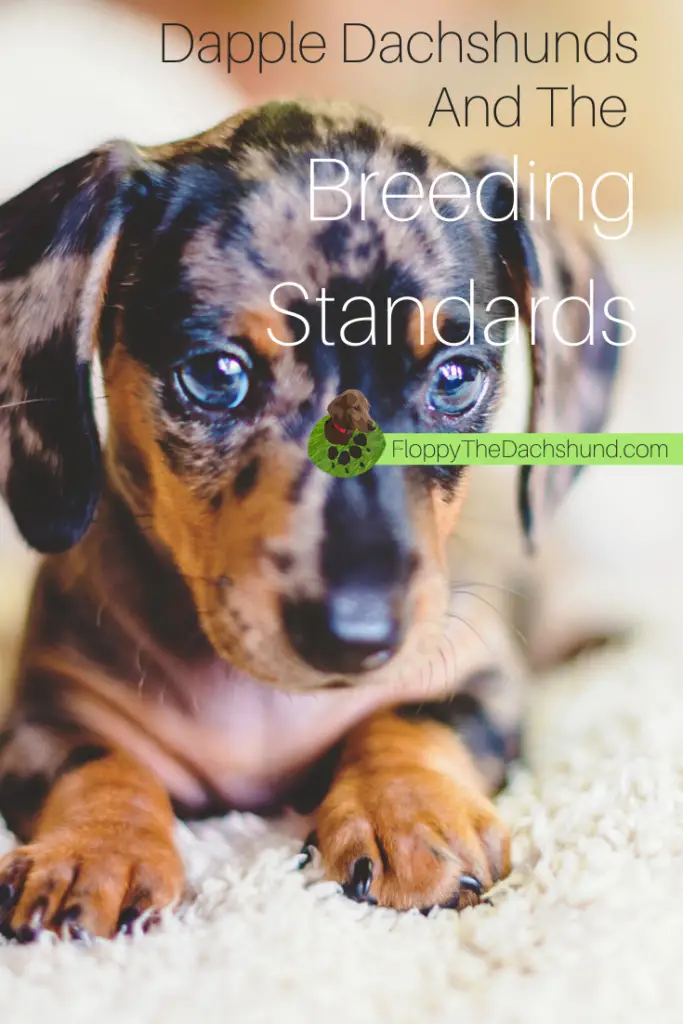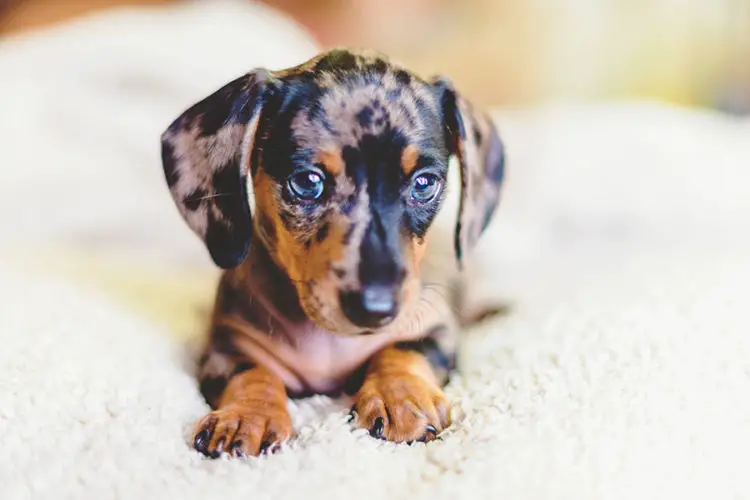Dachshunds are commonly owned pets in the U.S. and they come in many different colors. We dachshunds are available in three types of coats and four color patterns.
A dachshund can be long-haired or smooth-haired or wire-haired. Available in two different sizes, three base colors, three modifiers, and four patterns, there are approximately 216 different dachshund combinations.
Common Coat Patterns Available Among Dachshunds
Sable

A sable pattern is usually seen among wire-haired dachshunds. They have two core colors, one at the base and another on the tip of the hair. It is also a dominant gene.
Brindle
The brindle gene can make black or chocolate stripes appear on the base color of any dog and give him a zebra look. It is also a dominant gene.
Dapple
The dapple gene, merle, is a dominant gene and can change both base and modifier colors. The patches on the dog are of random sizes and on random sections of the body.
Piebald
Piebald have patches of white over their bodies. Piebald is a recessive gene.
Dominant and Recessive Genes
For a puppy to be sable, brindle or dapple, only one of his parents must be of the same pattern, therefore, they are dominant genes. Piebald is a recessive gene, which means both parents must have the piebald gene in order to transfer it to the puppy.
Are Dapple Dachshunds More Expensive Than Brindle or Sable?
The price of a dachshund depends upon the locality, breeder, and bloodline. It lies somewhere between $400 and $1100 depending on these factors. A double dapple dachshund is even more expensive than a dapple dachshund. A double dachshund can be spotted by the blueness of their eyes.
Dapple Dachshund
Dapple is a coat pattern seen among dogs that possess the merle gene. A merle gene gives a dog patches of color on their base color. On some dogs, these patches are very bright and easily seen, whereas on others, there might not be so many patches.
A dappled dachshund is available in a lot of different colors. Black and tan dapple, black and cream dapple, blue and cream dapple, chocolate dapple, chocolate, and tan dapple, silver dapple, red dapple, wild boar dapple, black and tan brindle dapple, and blue and tan piebald dapple are some of the most common dapple dachshunds.
Red and cream dachshunds often do not show their dapple patches. It is vital to get a pup checked for the merle gene before breeding them with another dog.
Breeding standard suggests that there should be no white patches on a dapple dachshund’s coat, except maybe on the chest. If there are any spots on other places, then it could reflect on their health. Also, white dachshunds, though it is the rarest dachshund color, are not approved by breeding standards. White dachshunds may look completely white, but they usually have a mix of genes that can cause health issues.
The Coat and What It Says About a Dachshund’s Health
Double Dapple Dachshund
When two merle dapples are bred together, the puppy is a double dapple dachshund. Double dapples are often born with a disability, related to their eyes and ears, which is why you must not adopt or breed a double dapple dachshund. It is better to breed your dachshund with another dachshund with a different coat pattern or better yet, with a dachshund that only has a base color. One out of every eleven double dachshunds is likely to be fully deaf.
Remember, many dapples look like they do not have merle genes in them because their patches are not darker than the base color, or their patches disappeared as they grew older. If you do not have adequate information about your dog’s parents, then it is essential to get a DNA test done to detect merle genes.
Piebald Dachshund
Moreover, a dog that carries both piebald and merle genes can be prone to more health conditions. Piebald is a recessive gene and for a puppy to be a piebald, both parents must be piebald. While piebald dachshunds do not face many health risks at this time, researchers claim that an increase in the white coloration of their coat can eventually bring pigment-related issues to the front, like deafness. Moreover, if a piebald is bred with a dapple, then it could experience the same health risks as a double dapple dachshund.
While a black and tan piebald can have white patches, it still cannot be referred to as a tricolor dachshund. There are no tri-colored dachshunds. The three colors could be a result of two merle genes and some others.
Isabella Dachshund
If a dachshund has two dilute genes inherited during breeding, the dilution of two colors, black and chocolate, can lead to blue or Isabelle-colored hair. Some dilute dachshunds suffer from CDA and other related issues, which is why we are not recognized by breeding standards.
A piebald, Isabella or a double dapple dachshund are often sold by breeders as a rare breed. A double dapple has blue eyes while a piebald or Isabelle dachshund can look different from other dachshunds. This uniqueness of the coat pattern makes people feel like they are adopting a fascinating dog. They are even ready to pay more money for these breeds. However, these dachshunds are prone to disabilities and health conditions. To ensure that their breeding is stopped, the demand for such a breed must lessen. Moreover, it is important to adopt from a breeder that follows breeding standards, as their primary concern would be the health and welfare of the dog. At the end of the day, our health matters way more than how different or fascinating we look.
How Do You Know That Your Dachshund is Purebred?
The Internet is a source of a lot of information, but you need to be careful because everything you read isn’t always accurate. We are available in many patterns and this variety of choice often confuses people about what to look for in a purebred dachshund. Many breeders on the Internet claim that a dog is a genuine purebred, but then the dog turns out to be a mix of terrier, beagle, and poodle.
To spot a purebred dachshund, you must look for a dog with short legs, a long back, long, floppy ears, a long snout, same-colored eyes, and a straight tail. If we have a small back, are too small in size or have long legs, then we are clearly not a purebred dachshund.
Conclusion
Great customer reviews and testimonials, along with recommendations, can help you find a purebred dachshund. Also, you can learn a lot about a dachshund by seeking the help of another dachshund owner.
Looking for a Cute Dachshund Gift?
Check out my outstanding quality coloring book for kids, now available on Amazon:
Famous Floppy The Dachshund goes on vacation around the world!
Color in his adventures in a cute book!
Read the interesting story!
Have a Ton of Fun!


